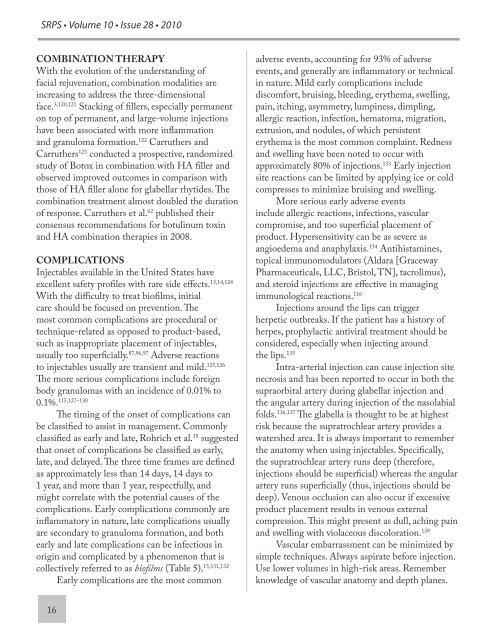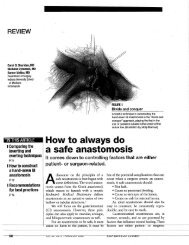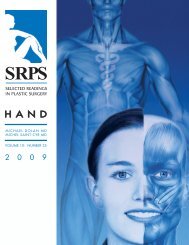Injectables - Plastic Surgery Internal
Injectables - Plastic Surgery Internal
Injectables - Plastic Surgery Internal
Create successful ePaper yourself
Turn your PDF publications into a flip-book with our unique Google optimized e-Paper software.
SRPS • Volume 10 • Issue 28 • 2010<br />
COMBINATION THERAPY<br />
With the evolution of the understanding of<br />
facial rejuvenation, combination modalities are<br />
increasing to address the three-dimensional<br />
face. 3,120,121 Stacking of fillers, especially permanent<br />
on top of permanent, and large-volume injections<br />
have been associated with more inflammation<br />
and granuloma formation. 122 Carruthers and<br />
Carruthers 123 conducted a prospective, randomized<br />
study of Botox in combination with HA filler and<br />
observed improved outcomes in comparison with<br />
those of HA filler alone for glabellar rhytides. The<br />
combination treatment almost doubled the duration<br />
of response. Carruthers et al. 62 published their<br />
consensus recommendations for botulinum toxin<br />
and HA combination therapies in 2008.<br />
COMPLICATIONS<br />
<strong>Injectables</strong> available in the United States have<br />
excellent safety profiles with rare side effects. 13,14,124<br />
With the difficulty to treat biofilms, initial<br />
care should be focused on prevention. The<br />
most common complications are procedural or<br />
technique-related as opposed to product-based,<br />
such as inappropriate placement of injectables,<br />
usually too superficially. 87,96,97 Adverse reactions<br />
to injectables usually are transient and mild. 125,126<br />
The more serious complications include foreign<br />
body granulomas with an incidence of 0.01% to<br />
0.1%. 115,127–130<br />
The timing of the onset of complications can<br />
be classified to assist in management. Commonly<br />
classified as early and late, Rohrich et al. 15 suggested<br />
that onset of complications be classified as early,<br />
late, and delayed. The three time frames are defined<br />
as approximately less than 14 days, 14 days to<br />
1 year, and more than 1 year, respectfully, and<br />
might correlate with the potential causes of the<br />
complications. Early complications commonly are<br />
inflammatory in nature, late complications usually<br />
are secondary to granuloma formation, and both<br />
early and late complications can be infectious in<br />
origin and complicated by a phenomenon that is<br />
collectively referred to as biofilms (Table 5). 15,131,132<br />
Early complications are the most common<br />
16<br />
adverse events, accounting for 93% of adverse<br />
events, and generally are inflammatory or technical<br />
in nature. Mild early complications include<br />
discomfort, bruising, bleeding, erythema, swelling,<br />
pain, itching, asymmetry, lumpiness, dimpling,<br />
allergic reaction, infection, hematoma, migration,<br />
extrusion, and nodules, of which persistent<br />
erythema is the most common complaint. Redness<br />
and swelling have been noted to occur with<br />
approximately 80% of injections. 133 Early injection<br />
site reactions can be limited by applying ice or cold<br />
compresses to minimize bruising and swelling.<br />
More serious early adverse events<br />
include allergic reactions, infections, vascular<br />
compromise, and too superficial placement of<br />
product. Hypersensitivity can be as severe as<br />
angioedema and anaphylaxis. 134 Antihistamines,<br />
topical immunomodulators (Aldara [Graceway<br />
Pharmaceuticals, LLC, Bristol, TN], tacrolimus),<br />
and steroid injections are effective in managing<br />
immunological reactions. 116<br />
Injections around the lips can trigger<br />
herpetic outbreaks. If the patient has a history of<br />
herpes, prophylactic antiviral treatment should be<br />
considered, especially when injecting around<br />
the lips. 135<br />
Intra-arterial injection can cause injection site<br />
necrosis and has been reported to occur in both the<br />
supraorbital artery during glabellar injection and<br />
the angular artery during injection of the nasolabial<br />
folds. 136,137 The glabella is thought to be at highest<br />
risk because the supratrochlear artery provides a<br />
watershed area. It is always important to remember<br />
the anatomy when using injectables. Specifically,<br />
the supratrochlear artery runs deep (therefore,<br />
injections should be superficial) whereas the angular<br />
artery runs superficially (thus, injections should be<br />
deep). Venous occlusion can also occur if excessive<br />
product placement results in venous external<br />
compression. This might present as dull, aching pain<br />
and swelling with violaceous discoloration. 138<br />
Vascular embarrassment can be minimized by<br />
simple techniques. Always aspirate before injection.<br />
Use lower volumes in high-risk areas. Remember<br />
knowledge of vascular anatomy and depth planes.






